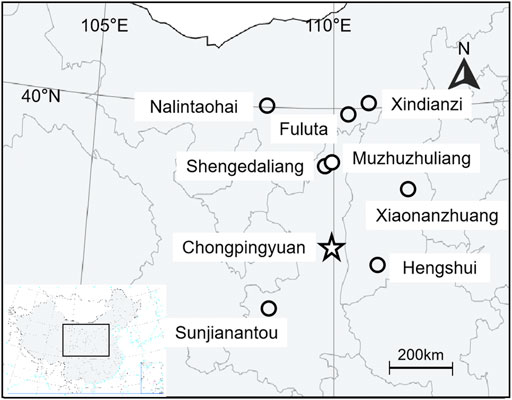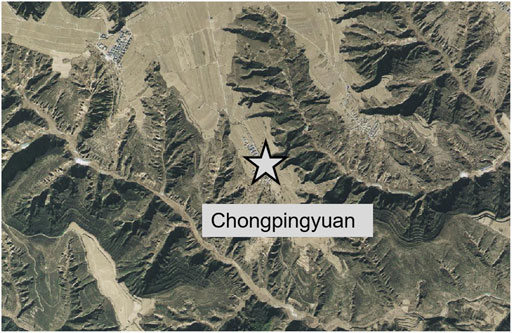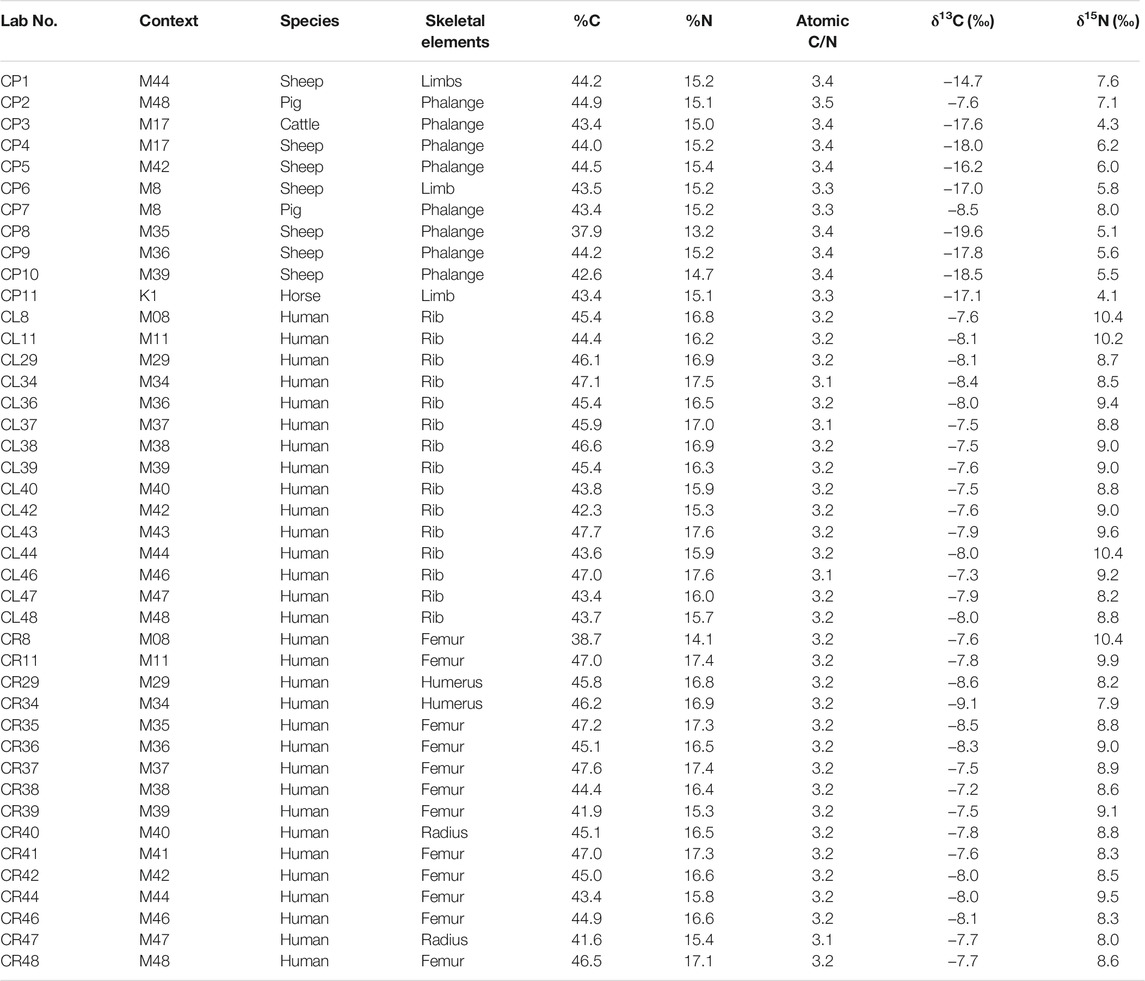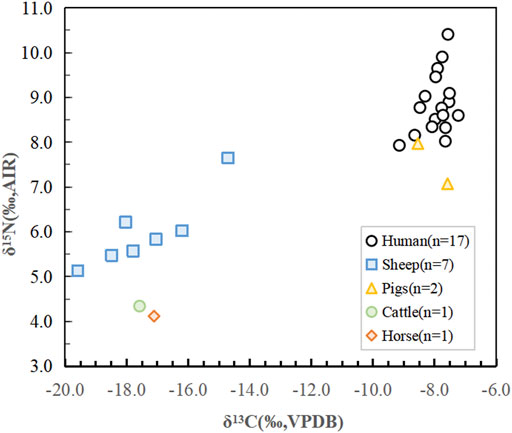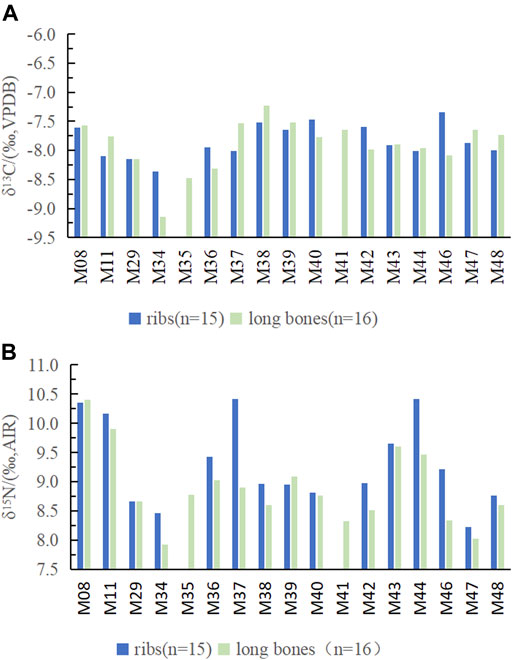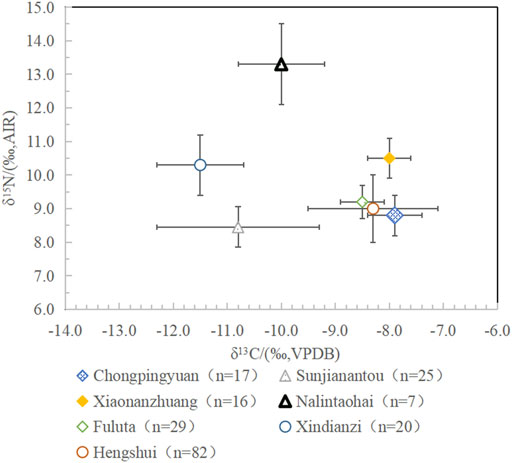- 1Key Laboratory of Vertebrate Evolution and Human Origins of Chinese Academy of Sciences, Institute of Vertebrate Paleontology and Paleoanthropology, Chinese Academy of Sciences, Beijing, China
- 2Department of Archaeology and Anthropology, University of Chinese Academy of Sciences, Beijing, China
- 3Department of Cultural Heritage and Museology, Fudan University, Shanghai, China
- 4Shaanxi Academy of Archaeology, Xi’an, China
Chinese history is composed of the contest, war, and admixture between the nomads in the north plateau and the farmers in central China. During the Eastern Zhou Period (770–221 BCE), nomadic groups, such as Rong (戎) and Di (狄), occupied the Eurasian Steppes and had frequent contact with the farmer group in Central China according historic records. This created a geographic boundary between the two groups named the agro-pastoral interweaving belt. To explore the impact of ethnic integration and human–animal interaction during the Eastern Zhou Dynasty, carbon and nitrogen stable isotope analysis of humans and animals at the Chongpingyuan site, Shaanxi, was undertaken. The δ13C (mean: -7.9 ± 0.5‰, n = 17) and δ15N values (mean: 8.8 ± 0.6‰, n = 17) for human and pigs (mean δ13C: −8.1 ± 0.5‰; mean δ15N:7.5 ± 0.5‰, n = 2) revealed that they consumed C4-based foods mainly while the δ13C and δ15N values of cattle (−17.6‰, 4.3‰, n = 1), horse (−17.1‰, 4.1‰, n = 1), and sheep (mean: −17.4 ± 1.5‰, 6.0 ± 0.8‰, n = 7) suggest that they relied on C3 plants supplemented with minor C4 plants. Based on the archaeological and historic contexts, we infer that humans at Chongpingyuan survived on an agro-pastoral economy with millet agriculture as the economic foundation. Given the isotopic spacing between humans and animals, we found that pigs contributed to the main sources of animal protein, whereas other animals might have been provisioned for other purposes, such as rituals or properties. In general, no significantly dietary differences between genders and funeral customs are found, but people with abundant burial objects seem to have consumed more animal protein, possibly related to social heterogeneity.
Introduction
Influenced by the fluctuation of East Asia monsoon and human activities, there was an agro-pastoral ecotone in Northern China (Chen et al., 2010; Shi and Shi, 2018; Damette et al., 2020). Northern Shaanxi is located on the Loess Plateau, a typical area of agro-pastoral ecotone in history (Shi, 1999). Historic records suggest several ethnic groups, such as Rong (戎), Di (狄), and Huaxia (華夏), occupied here since the Western Zhou Dynasty (1046BCE to 771BCE) (Yang, 2009; Shan, 2015). In the East Zhou period, archaeological remains affiliated to Eurasian steppe and Central Plains styles could be found (Teng and Wang, 2011; Shan, 2015), indicating the coexistence of multiple cultures and populations living simultaneously in this region. So far, there is a lack of direct evidence of human subsistence strategies and human–animal interactions in this region to show the cultural and population interplay between different ethnic groups.
The Chongpingyuan site (N36°01, E110°07) is located in Yichuan County of Yan’an City, Shaanxi Province of China (Ding et al., 2018). The site is on the central part of Loess Plateau, with ravines crisscrossing the territory (Figures 1, 2). In 2014, the Shaanxi Provincial Institute of Archaeology and Yichuan County Museum conducted exploration and excavation of the Chongpingyuan site. Within the site, 21 tombs, one chariot-and-horse pit, three ash pits, and two ditches were unearthed (Ding et al., 2018). The characteristics of the funeral objects and chariot-and-horse pit (Figure 3) in the Chongpingyuan site were similar to the Central Plains (Li, 2018), but the tomb orientations and the customs of animal sacrifices in some tombs suggested that local ethnic culture might also have had an impact on the Chongpingyuan site (Chen, 2020; Sun, 2020).
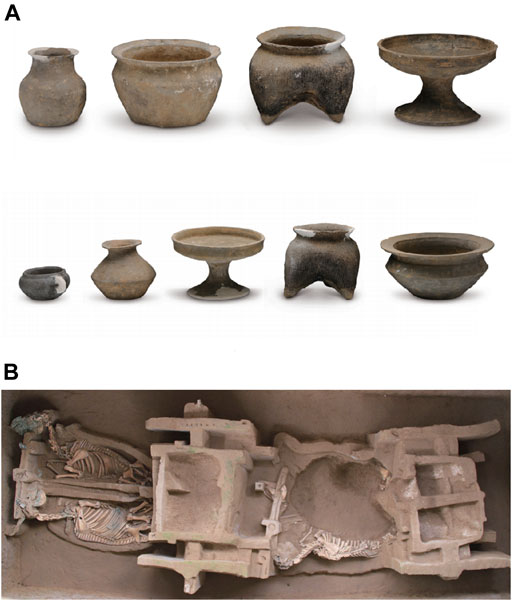
FIGURE 3. Pottery (A) and chariot-and-horse pit (B) recovered from the tombs of the Chongpingyuan site (Ding et al., 2018).
By analyzing the carbon and nitrogen stable isotopes in the bone collagen of human and animals, we can understand the contribution of C4- or C3-based foods in human diets (Ambrose, 1991; Hedges, 2003; Lee-Thorp, 2008) and the categories of animal protein (Kohl et al., 1980). Isotope analysis has succeeded in revealing prehistoric human subsistence strategies under different natural environments and cultural backgrounds in this region (Zhang et al., 2006; Zhang et al., 2017; Tang et al., 2018; Liu et al., 2021). In this study, stable isotope analysis of humans and animals at the Chongpingyuan site in northern Shaanxi was undertaken to investigate the human lifestyles and interactions with humans and animals during the Eastern Zhou Dynasty.
Materials and Methods
Sample Selection
In this study, 42 samples in total from 17 humans (including 15 ribs and 16 long bones), seven sheep, two pigs, one cow, and one horse were used (Table 1). In particular, the human samples were selected according to the differences of gender, burial posture, and sacrificed animals (Table 2). The identification of age, gender, and other physical characteristics was performed by Chen (Chen et al., 2018). Meanwhile, other archaeological contexts come from the excavation briefs (Ding et al., 2018).
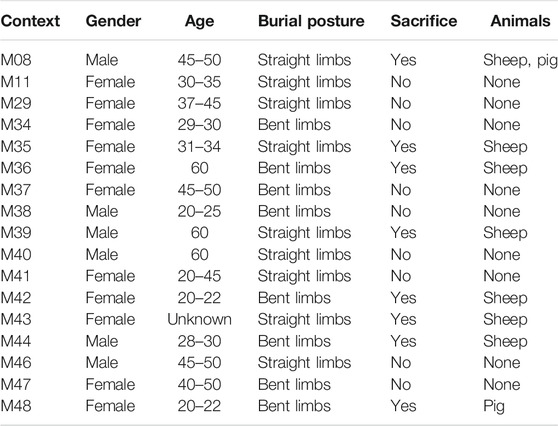
TABLE 2. The burial details of Chongpingyuan tombs (Chen et al., 2018; Ding et al., 2018).
Radiocarbon Dating of Collagen
Two human bone samples were AMS Radiocarbon dated by Beta Analytic, Inc., and were calibrated by the BetaCal4.20: HPD method (INTCAL20). The results show that the age of M8 is 2480 ± 30 cal a BP, and the age of M34 is 2410 ± 30 cal a BP (Table 3). It showed that these people lived in the spring and autumn period (770 to 403BCE), and the result is consistent with the judgment given through the archaeological remains (Chen et al., 2018; Ding et al., 2018).
Collagen Preparation and Isotopic Measurements
The method for extracting collagen came from Richards and Hedges (Richards and Hedges, 1999) and was modified with ultrafiltration before lyophilization (Brown et al., 2016). After cleaning the contaminants on the surface of bones, 2–3 g of bone samples were weighed and immersed in 0.5 M HCl at 4°C. HCl was replaced every 48 h until there were no obvious bubbles on the surface of the bones, and then the samples were eluted to neutral with deionized water. The neutral samples were soaked in 0.125 M NaOH for 20 h at 4°C and then washed with deionized water until neutral. The bone samples were soaked in 0.001M HCl, heated in an oven at 70°C for 48 h, and then filtered while hot to obtain a collagen solution. Finally, the solution was freeze-dried to obtain collagen.
The stable isotope values of C and N contents of the collagen samples were measured by the laboratory of the Department of Archaeology and Anthropology, University of Chinese Academy of Sciences. The samples were measured on an IsoPrime-100 IRMS. The contents of carbon and nitrogen elements were determined with sulfanilamide as the standard substance. Stable isotope of carbon was calibrated to VPDB and AIR standards by using IAEA-600, IAEA-CH-6, IAEA-N-2, USG5 40 and USG5 41 as standard substance. Two-point calibration was used to calibrate the raw isotope values. After every 10 samples, a standard collagen sample made by the laboratory (δ13C −14.7 ± 0.2‰, δ15N 7.0 ± 0.2‰) was inserted to the sample list to calibrate the precision. The precision for C and N was determined to±0.2‰ of calibration standards, check standards.
All 42 collagen samples were successfully extracted (Table 1). The %C values (37.9%–47.7%, average 44.6% ± 2.1%) were higher than 13%, and the %N values (13.2%–17.6%, average 16.1% ± 1.0%) were higher than 4.8% (Deniro, 1985). The atomic C/N ratios of bone collagen were between 3.1 and 3.4 within the acceptable range of 2.9–3.6 (Ambrose, 1990). It reflected that samples of collagen were not degraded, and they were useable for stable isotope analysis.
Result and Discussion
Animal Feeding Practices
The stable isotope value of an organism (human and animals) depends on the isotopic composition of its food. The δ13C value of C3 plants is in the range of -30–23‰ (average −26.5‰), and δ13C value of C4 plants range of −16–9‰ (average −12.5‰) (Farquhar et al., 1989; van der Merwe and Medina, 1991). From food to collagen, the δ13C value is enriched 5‰, and this value was varied because of the different composition of micro-biomolecules (Lee-Thorp et al., 1989; Lee-Thorp, 2008) while the δ15N value enriched 3-5‰(Hedges and Reynard, 2007).
The δ13C and δ15N values of sheep, pigs, cattle, and horses are all shown on Table 1 and Figure 4. The ranges of stable isotope values vary greatly from one species to another, indicating that animals may be raised in different ways. The pigs have the most positive δ13C values (mean: −8.1 ± 0.5‰, n = 2) and the highest δ15N values (7.5 ± 0.5‰, n = 2), which indicates that pigs consumed C4 based foods, C4 plants and/or animals consuming C4 plants mainly (Hu, 2019; Hu et al., 2020; Hou et al., 2021a; Hou et al., 2021b). Considering the fact that there is a long history of millet agriculture in northern Shaanxi (Sheng et al., 2018) and both millets (Panicum miliaceum, Setaria italica) are attributed to C4 plants crops while the local vegetation was dominated by C3 plants (Zhou et al., 2009), we suggest that pigs might have been fed by millet by-products.
Sheep had the largest numbers in all unearthed domestic animals (n = 7) and had varied isotopic data. Their mean value δ13C −17.4 ± 1.5‰ (range −19.6–14.7‰) suggests that sheep survived on mixed C3/C4-based diets and consumed C4 food to varying degrees. The lowest δ13C value of sheep (−19.6‰) reflected a C3-based diet, and it was close to wild animals in northern Shaanxi (Wang et al., 2018). Meanwhile, the highest δ13C value (−14.7‰) suggested a higher proportion of C4 plants in its food. The large range of δ13C value suggested that sheep probably had a wide range of foraging ecology. δ13C value of cattle (n = 1) was −17.6‰, and δ13C value of horse (n = 1) was −17.1‰, indicating that both cattle and horse fed on mixed C3/C4 plants with C3 plants dominated. The similarity of δ13C values among cattle, horse, and sheep suggests that they probably subsisted on similar fodders. Comparing the isotope results of sheep on Chongpingyuan site with sheep of different feeding patterns on modern Inner Mongolia, the isotope results of sheep on Chongpingyuan was between those of grassland pasturing sheep (δ13C −21.6 ± 3.5‰, n = 87) and barn feeding sheep (δ13C −14.6 ± 1.0‰, n = 17) (Wang, 2021) suggesting that sheep in Chongpingyuan were probably mixed grassland pasturing and barn feeding. C3 plants are the main fodder for cattle, sheep, and horse, reflecting their diets based on wild plants in the natural environment mainly (Zhou et al., 2009). However, roles of C4 foods could not be ignored. The diets of these domestic animals contained different proportions of C4 plants like millet by-products. It showed that animal husbandry in Chongpingyuan was closely related to the millet agriculture. In response to winter grass shortages, herders supplemented their grazing animals with C4 fodders, which would lead to higher δ13C values (Makarewicz, 2015). The mixed C3/C4 diet suggested people in the Eastern Zhou Dynasty probably had begun to use millet by products to help livestock survive in the winter.
The kill-off patterns of animals were closely related to their usages by humans. Most of the sacrificial animals in Chongpingyuan were juveniles, which suggested they might be raised as meat animals (Payne, 1973). Meanwhile, some sheep unearthed in Chongpingyuan were adult individuals that indicated they might be used for second products (Vigne and Helmer, 2007). Ancient people from the Taosi site in the Bronze Age may have started raising sheep for second products, such as wool, and these sheep would be slaughtered after adulthood (Brunson et al., 2016). People in the Eastern Zhou Dynasty might already have diverse patterns of livestock husbandry and utilization.
According to the Liji (禮記), people used livestock as sacrifice, and people chose different animals according to their status as cattle were the highest grade called Tailao (太牢), sheep the next called Shaolao (少牢), and pigs the lowest grade called Kuishi (馈食) (Xie, 2018). According to the archaeological discoveries although sheep were not mainly a meat source of human diets, they were the most common sacrificial animals throughout the Eastern Zhou Dynasty (Zuo, 2018; Zhao, 2020; Hou et al., 2021a). In that case, sacrificial animals of Chongpingyuan were the manifestation of this sacrificial culture.
The Human Diets
In Table 1, the δ13C values of the individuals were in a very narrow range (−9.2–7.2‰) with the mean of −7.9 ± 0.5‰ (n = 17). It suggests that these individuals consumed C4-based foods. Their high δ13C values indicate that millet agriculture played a significant role in their foods. The mean δ15N value of human (n = 17) is 8.8 ± 0.6‰, characteristic of terrestrial animal protein. However, the large range of δ15N values, from 7.9 to 10.4‰, indicated meat intake might be internally different within the human group.
From the diet protein to collagen, the δ13C values were enriched by 1–1.5‰, (Lee-Thorp, 2008) while δ15N values enriched 3–5‰ (Hedges and Reynard, 2007). Comparison of δ13C and δ15N values among humans and animals indicates between pigs and humans (−0.2‰, 1.3‰), sheep and humans (9.5‰, 2.8‰), cattle and humans (9.8‰, 4.7‰), and horse and humans (9.3‰, 4.5‰). When the isotopic fractionation from the diets to collagen is considered, we can see that only pigs have the similar δ13C and δ15N values to humans, strongly indicating the animal protein in human diets came from pigs mainly but not from other animals. Other animals could be utilized for other purposes, such as animal power, wool, or milk (Zhao et al., 2017; Hou et al., 2021a).
Given the turnover differences of various skeletal elements, the stable isotope values of the ribs indicated their average diets for 2–5 years before death, whereas those of long bones indicated the average diet for 10–15 years before death (Parfitt, 2002; Hedges et al., 2007). Comparison of the δ13C and δ15N values from ribs and long bones in the same individual shows their diet changed throughout their different lifetime (Figure 5). The mean δ13C value of ribs (n = 15) is −7.8 ± 0.3‰, and the value of long bones (n = 16) is −7.9 ± 0.4‰ (Figure 5A). The mean δ13C difference between ribs and long bones (0.1‰) is within the analytical precision and paired t-test (p = 0.23, n = 14) indicates there is no significant difference, suggesting that their diets changed hardly. The mean δ15N value of ribs (n = 15) is 9.3 ± 0.7‰, and the value of long bones (n = 16) is 8.8 ± 0.6‰ (Figure 5B). A paired t-test (p = .0004 < .01, n = 14) indicated there is significant increase (0.3 ± 0.3‰, n = 14) through time. This could be caused by the more animal protein consumption or abnormal physiology before death.
To test the possible internal differentiation in the Chongpingyuan people, isotope results were divided by gender (pG), burial posture (pP), and with or without sacrifices (pS) in their tombs and used multivariate analysis of variance (MANOVA) to access the internal difference. The isotopic results reflected that the δ13C values of the Chongpingyuan human group had no significant difference in these factors (pG = 0.19, pP = 0.82, pS = 0.52). MANOVA of δ15N values (pG = 0.36, pP = 0.31, pS = 0.06) showed that gender and burial posture had no significant effect on meat consumption. However, the p value of whether to have sacrifices is close to 0.05, and the mean δ15N values of humans with sacrifices (9.2 ± 0.6‰, n = 8) were higher than humans without sacrifices (8.6 ± 0.6‰, n = 9), suggesting sacrifice custom might be related to meat consumption.
However, some individuals have higher δ15N values among the human population, like M08 (10.4‰), M11 (9.9‰), and M44 (9.5‰). The tomb of M08 was the second largest one in the Chongpingyuan site, and more funeral objects were found. Apart from M08, M44 also had many funeral objects. On the contrary, M34 had the lowest δ15N value (7.9‰), indicating that she consumed the least animal protein. This could be related to her lower social status evidenced by the few items in her tomb (Ding et al., 2018). In ancient times, the rich owned more wealth, and they could consume better foods, which meant more animal protein in their food resources (Zhou, 2020). Zhouli (周禮) recorded that the Zhou Dynasty divided people into different classes and stipulated their daily life from various aspects, and the use of animals, including the consumption of diet meat and species of animals using for sacrifices (Chen, 2016). The social hierarchical structure affected the meat consumption of humans.
All in all, different genders and cultural characteristics did not have significant difference in the population’s subsistence strategies, but the higher class seemed to consume more animal protein. All the people in the Chongpingyuan site lived on an agro-pastoral economy.
Agro-Pastoral Economy in Northern Shaanxi
After 4000 BP, the climate had deteriorated from warm and humid to dry and cold (Xu et al., 2020). In some areas in northern China, such as the Xinjiang and Hexi corridor, the proportion of agriculture in the livelihood economy decreased, and the stockbreeding component increased, eventually turning into a nomadic economy (Wang et al., 2019; Yang et al., 2019; Damette et al., 2020). Pollen evidence shows the decrease in trees and increase in herbs in northern Shaanxi after the Longshan Period (He et al., 2000).
The study of plant remains showed that people planted millet during the Neolithic Period in northern Shaanxi. Ancestors had already begun to grow millet in the Yangshao period, but the number and probability of archaeological excavations were very low (Sheng et al., 2017; Liu et al., 2019). Until the Longshan Period, agriculture in northern Shaanxi was developed as the number of food crops and the probability of excavation in the archaeological sites were significantly improved (Gao, 2017; Sheng et al., 2018; Liu et al., 2019). Although sheep and other pastoral-related animals began to appear in northern Shaanxi since 4500 a BP(Hu et al., 2016; Guo, 2017), isotopic evidence showed that the subsistence strategies were dominated by millet farming, and the grassland animal husbandry took very little part in the local economy (Chen et al., 2015; Chen et al., 2017). However, by the Eastern Zhou Dynasty, the amount of millet unearthed in archaeological sites was very small, and the probability of being unearthed was also very low (Liu et al., 2019), which implied that agriculture in this region probably encountered difficulties.
The comparison of isotopes of the people in the Longshan Period and the Eastern Zhou Period was similar to each other, which indicated that their diet structure stayed consistent over time (Figure 6). People in northern Shaanxi always lived on agro-pastoral economics from the late Longshan Period to the Eastern Zhou Period. Although there were negative factors to the agriculture, the local people did not show an obvious trend of nomadism. The complementary mixed economies of agriculture and livestock helped them challenge environmental degradation.
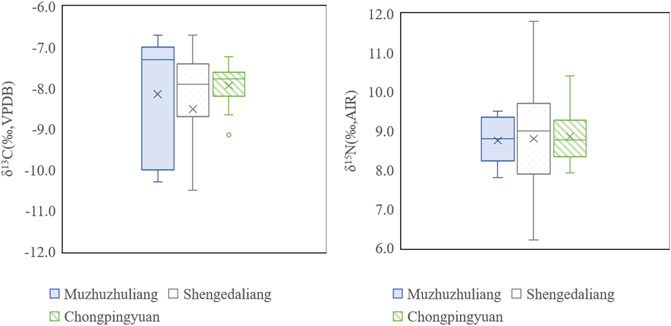
FIGURE 6. The boxplots of carbon (A) and nitrogen isotopes (B) humans in Northern Shaanxi from the Longshan Period to the East Zhou Dynasty.
Subsistence Strategy Around Agro-Pastoral Ecotone
To better understand the subsistence strategies of local ancestors during the Eastern Zhou Dynasty, stable isotopes from the Chongpingyuan site were compared with data from surrounding archaeological sites, ranging from the West Zhou Period to the Qin and Han Dynasties. The locations of these sites are indicated in Figure 1, and their isotope data are indicated in Table 4 and Figure 7.
The results show that, around the northern Shaanxi region, people from all those sites relied on C4 food as their main food source. Among all these people, the people on the Chongpingyuan site had the highest δ13C value, indicating that the people on the Chongpingyuan site also had the highest proportion of C4 food in their food source. In other words, their food mainly depended on millet agriculture.
The Sunjiannantou, Xindianzi, and Nalintouhai people had relatively lower δ13C values, which indicates that they also consumed a certain amount of C3 food (Zhang et al., 2006; Ling et al., 2010; Zhang et al., 2012). The Xindianzi people, likely related to Huns (匈奴), had a more developed animal husbandry economy, and the C3 food would come from the animals they graze in the wild (Zhang et al., 2006). Wheat was first introduced into China from Xinjiang 5700 a BP, and people in the central Plains began to grow a certain amount of wheat (Ling et al., 2010; Tang et al., 2018; Zhou et al., 2020). The lower isotope carbon value in some areas might be related to the promotion of wheat cultivation (Zhang et al., 2012; Tao et al., 2020). But people in most regions like the Chongpingyuan still relied on C4 plants, millet, as their farming economics.
By comparing the δ15N values of various sites, the data showed that the δ15N values of the people in the Chongpingyuan site were relatively low, only slightly higher than that of Sunjiannantou people, and slightly lower than people of Hengshui and Fuluta (Ling et al., 2010; Sun, 2019; Hou et al., 2021a). Meanwhile, the people of Nalintaohai, Xindianzi, and Xiaonanzhuang had significantly higher δ15N values than other people, indicating that they consumed more animal protein and were more engaged in nomadic life (Zhang et al., 2006; Zhang et al., 2012; Tang et al., 2018). The analysis indicated that, from the Eastern Zhou Period to the Qin and Han Dynasties, some people in northern China turned to nomadic life from agriculture, like Nalintaohai, but major people around the Great Wall area remained with their millet-based economy with animal husbandry as supplements. Although these regions also had a certain proportion of animal husbandry, their animal husbandry was dependent on their millet agriculture.
As previous studies show, during the Eastern Zhou Dynasty, multiple ethnic groups surrounded the Great Wall area, which was also an agro-pastoral ecotone. Due to ethnic habits and culture, people in these regions chose different subsistence strategies. The people close to the Huns (Xindianzi, part of Xiaonanzhuang) were more inclined to be nomads while the people of the Central Plain in Guanzhong area (Sunjianantou) were mainly engaged in millet agriculture. Apart from representative agriculture and nomadic life, people living on the cultural borders (Chongpingyuan, Hengshui) lived on agro-pastoral economies, which were mainly engaged in millet agriculture and supplemented by animal husbandry, which was attached to agriculture. Until the Qin and Han Dynasties, due to the dynasty expansion, the southern agricultural population migrated to the Loess Plateau, but these new immigrants chose the same subsistence strategies as the previous indigenous people. The impact of the natural environment on the subsistence strategies exceeded that of ethnicity and culture.
Conclusion
From the results of stable carbon and nitrogen isotope analysis of people and burial animals in the Chongpingyuan site in northern Shaanxi during the Eastern Zhou Dynasty, several conclusions can be drawn. The subsistence strategies of the Chongpingyuan people are agro-pastoral economics. Individuals mainly consume C4 plants (millet), and domestic animals (pigs) fed on C4 products. Cattle, sheep, and horses are not the main source of animal protein. There are no significant differences between genders and funeral customs, but people with abundant burial objects consumed more animal protein, showing possible class divisions.
Data Availability Statement
The original contributions presented in the study are included in the article/Supplementary Material, further inquiries can be directed to the corresponding authors.
Author Contributions
CM, SX, and HY conceived the project. CM conducted data analysis. All authors shared ideas, contributed to the interpretation of the results, and to the writing of the manuscript.
Funding
This study was supported by grants from the national social science fund for their financial support (No. 21BKG040).
Conflict of Interest
The authors declare that the research was conducted in the absence of any commercial or financial relationships that could be construed as a potential conflict of interest.
Publisher’s Note
All claims expressed in this article are solely those of the authors and do not necessarily represent those of their affiliated organizations, or those of the publisher, the editors and the reviewers. Any product that may be evaluated in this article, or claim that may be made by its manufacturer, is not guaranteed or endorsed by the publisher.
References
Ambrose, S. H. (1991). Effects of Diet, Climate and Physiology on Nitrogen Isotope Abundances in Terrestrial Foodwebs. J. archaeological Sci. 18, 293–317. doi:10.1016/0305-4403(91)90067-y
Ambrose, S. H. (1990). Preparation and Characterization of Bone and Tooth Collagen for Isotopic Analysis. J. Archaeological Sci. 17, 431–451. doi:10.1016/0305-4403(90)90007-r
Brown, T. A., Nelson, D. E., Vogel, J. S., and Southon, J. R. (2016). Improved Collagen Extraction by Modified Longin Method. Radiocarbon 30, 171–177. doi:10.1017/s0033822200044118
Brunson, K., He, N., and Dai, X. (2016). Sheep, Cattle, and Specialization: New Zooarchaeological Perspectives on the Taosi Longshan. Int. J. Osteoarchaeol. 26, 460–475. doi:10.1002/oa.2436
Chen, F. (2020). A Study on the Tombs of Eastern Zhou Dynasty on the Banks of the Yellow River. Jinlin University.
Chen, L., Ding, Y., Xiong, J., and Li, Y. (2018). Research on the Human Bones Unearthed from the Chongpingyuan Site in Yichuan County, Shaanxi. Archaeology Cult. Relics 29, 118–128.
Chen, S., Guo, Y., and Zheng, Y. (2010). Temporal and Spatial Variation of Annual Mean Air Temperature in Arid and Semiarid Region in Northwest China over a Recent 46 Year Period. J. Arid Land 2, 87–97. doi:10.3724/sp.j.1227.2010.00087
Chen, X., Guo, X., Hu, Y., Wang, W., and Wang, C. (2015). Analysis of Diets of the Ancestors at the Muzhuzhuliang Site in Shenmu, Shaanxi. Archaeology Cult. Relics 26, 112–117.
Chen, X., Guo, X., Wang, W., Hu, S., Yang, M., Wu, Y., et al. (2017). The Subsistence Patterns Ofthe Shengedaliang Site (∼4,000 Yr BP) Revealed by Stable Carbon and Nitrogen Isotopes in Northern Shaanxi, China. Sci. China Earth Sci. 47, 95–103.
Damette, O., Goutte, S., and Pei, Q. (2020). Climate and Nomadic Migration in a Nonlinear World: Evidence of the Historical China. Climatic Change 163, 2055–2071. doi:10.1007/s10584-020-02901-4
Deniro, M. J. (1985). Postmortem Preservation and Alteration of In Vivo Bone Collagen Isotope Ratios in Relation to Palaeodietary Reconstruction. Nature 317, 806–809. doi:10.1038/317806a0
Ding, Y., Li, Y., Song, Y., Yang, J., He, N., Jin, H., et al. (2018). Brief Report on Excavation of Chongpingyuan Site, Yichuan County, Shaanxi. Archaeology Cult. Relics 39, 3–21+22+145.
Farquhar, G. D., Ehleringer, J. R., and Hubick, K. T. (1989). Carbon Isotope Discrimination and Photosynthesis. Annu. Rev. Plant Physiol. Plant Mol. Biol. 40, 503–537. doi:10.1146/annurev.pp.40.060189.002443
Gao, S. (2017). Research on the Plant Remains of the Shimao Site in Shenmu. Northern Shaanxi Northwest University.
Guo, X. (2017). The Substitence Strategies in the Late Longshan Period in Northern Shaanxi: Muzhuzhuliang and the Relics of Plants and Animals at the Shengeyaliang Site. Agric. Archaeology 28, 19–23.
He, X., Liang, Y., and Tian, J. (2000). Pollen Analysis of Holocene Loess and Vegetation Evolution in Yan’an Area. Res. Soil Water Conservation 21, 124–127.
Hedges, R. E. M., Clement, J. G., Thomas, C. D. L., and O'connell, T. C. (2007). Collagen Turnover in the Adult Femoral Mid-Shaft: Modeled from Anthropogenic Radiocarbon Tracer Measurements. Am. J. Phys. Anthropol. 133, 808–816. doi:10.1002/ajpa.20598
Hedges, R. E. M. (2003). On Bone Collagen—Apatite‐Carbonate Isotopic Relationships. Int. J. Osteoarchaeol. 13, 66–79. doi:10.1002/oa.660
Hedges, R. E. M., and Reynard, L. M. (2007). Nitrogen Isotopes and the Trophic Level of Humans in Archaeology. J. Archaeological Sci. 34, 1240–1251. doi:10.1016/j.jas.2006.10.015
Hou, L., Hu, C., Wu, T., Zhao, Y., Deng, H., and Guo, Y. (2021a). Human Subsistence Strategy in the Ordos Plateau, Inner Mongolia, China, during the Qin and Han Dynasties: Using Stable Isotope Analysis. Int. J. Osteoarchaeology 31, 833–845. doi:10.1002/oa.2994
Hou, L., Li, J., Deng, H., and Guo, Y. (2021b). Stable Isotope Analysis of Animal Skeletons at Nanzhuangtou Site in Xushui. Hebei Archaeology 67, 107–114.
Hu, J. (2019). A Study on Feeding Practices and Sources of Pig-Sacrifices from Yanshi Shangcheng-Based on Carbon, Nitrogen and Oxygen Stable Isotope Analysis of Pigs' Bones. Zhejiang University.
Hu, S., Yang, M., Sun, Z., and Shao, J. (2016). Research on the Animal Remains Unearthed from the Shimao Site in Shenmu, Shaanxi from 2012 to 2013. Archaeology Cult. Relics 37, 109–121.
Hu, Y., Zhang, X., Wang, T., Yang, Q., and Hu, S. (2020). Raising Patterns of Domestic Animals at the Xinglefang Site, Huayin County, Shaanxi and Their Contribution to Human Meat Resources. Quat. Sci. 40, 399–406. doi:10.11928/j.issn.1001-7410.2020.02.10
Kohl, H. H., Wheatley, W. B., Worley, S. D., and Bodor, N. (1980). Antimicrobial Activity of N-Chloramine Compounds. J. Pharm. Sci. 69, 1292–1295.
Lee-Thorp, J. A. (2008). On Isotopes and Old Bones*. Archaeometry 50, 925–950. doi:10.1111/j.1475-4754.2008.00441.x
Lee-Thorp, J. A., Sealy, J. C., and Van Der Merwe, N. J. (1989). Stable Carbon Isotope Ratio Differences between Bone Collagen and Bone Apatite, and Their Relationship to Diet. J. Archaeological Sci. 16, 585–599. doi:10.1016/0305-4403(89)90024-1
Li, Y. (2018). A Preliminary Study on Chongping Site, Yichuan, Shaanxi. Archaeology Cult. Relics, 61–66.
Ling, X., Chen, L., Tian, Y., Li, Y., Zhao, C., and Hu, Y. (2010). Analysis of C and N Isotopes in Human Bone Unearthed from the Tomb of Qin at Sunjia Nantou in Fengxiang, Shaanxi. Acta Anthropologica Sinica 29, 54–61.
Liu, X., Wei, D., Wang, T., Zhang, X., and Hu, Y. (2021). Stable Isotope Analysis Reveals an Agricultural Economy in Southeast Inner Mongolia during the Warring States Period. Acta Anthropologica Sinica 40 (05), 764–775. doi:10.16359/j.cnki.cn11-1963/q.2020.0074
Liu, Y., Sheng, P., Zhang, P.-C., and Shang, X. (2019). Preliminary Analysis of Flotation Plant Remains from Panshang Site, Fuxian County, Shaanxi Province. Archaeology Cult. Relics 40, 116–124.
Makarewicz, C. A. (2015). Winter Is Coming: Seasonality of Ancient Pastoral Nomadic Practices Revealed in the Carbon (δ13C) and Nitrogen (δ15N) Isotopic Record of Xiongnu Caprines. Archaeol Anthropol. Sci. 9, 405–418. doi:10.1007/s12520-015-0289-5
Parfitt, A. M. (2002). Misconceptions (2): Turnover Is Always Higher in Cancellous Than in Cortical Bone. Bone 30, 807–809. doi:10.1016/s8756-3282(02)00735-4
Payne, S. (1973). Kill-off Patterns in Sheep and Goats: the Mandibles from Aşvan Kale. Anatol. Stud. 23, 281–303. doi:10.2307/3642547
Richards, M. P., and Hedges, R. E. M. (1999). Stable Isotope Evidence for Similarities in the Types of marine Foods Used by Late Mesolithic Humans at Sites along the Atlantic Coast of Europe. J. Archaeological Sci. 26, 717–722. doi:10.1006/jasc.1998.0387
Shan, Y. (2015). The Cultural Pattern of Archaeology in Northern China in the Eastern Zhou Dynasty and Qin Dynasty——Also on the Interaction between Rong, Di, Hu and Huaxia. Acta Archaeologlca Sinica 80, 303–344.
Sheng, P., Shang, X., Sun, Z., Yang, L., Guo, X., and Jones, M. K. (2018). North-South Patterning of Millet Agriculture on the Loess Plateau: Late Neolithic Adaptations to Water Stress, NW China. The Holocene 28, 1554–1563. doi:10.1177/0959683618782610
Sheng, P., Shang, X., Yang, L.-P., Zhang, P.-C., Hao, J., Wang, H., et al. (2017). Preliminary Study on the Plant Remains of Yangjiesha Site in Hengshan, Shaanxi. Archaeology Cult. Relics 38, 123–128.
Shi, N. (1999). The Transition and Influence of the Boundary between Farming and Pasturing on the Loess Plateau Planned by Sima Qian. J. Chin. Hist. Geogr. 15, 3–5.
Shi, X., and Shi, W. (2018). Review on Boundary Shift of Farming-Pastoral Ecotone in Northern China and its Driving Force. Trans. Chin. Soc. Agric. Eng. 34, 1–11.
Sun, Y. (2019). Carbon and Nitrogen Stable Isotope of the Human and Animal Bones from the Hengshui Cemetery. Shanxi University.
Sun, Z. (2020). On the "Remains of Xinzhuang Type" in the Warring States Period in Northern Shaanxi. Archaeology Cult. Relics 29, 79–87.
Tang, M., Wang, X., Hou, K., and Hou, L. (2018). C and N Stable Isotopes of Human Bones in Xiaonanzhuang Cemetery, Jinzhong, Shanxi: An Analysis of the Promotion of Wheat in Shanxi. Acta Anthropologica Sinica 37, 318–330.
Tao, D., Zhang, G., Zhou, Y., and Zhao, H. (2020). Investigating Wheat Consumption Based on Multiple Evidences: Stable Isotope Analysis on Human Bone and Starch Grain Analysis on Dental Calculus of Humans from the Laodaojing Cemetery, Central Plains, China. Int. J. Osteoarchaeol 30, 594–606. doi:10.1002/oa.2884
Teng, M., and Wang, C. (2011). The Northern Cultural Factors in the Sanjin Area in the Eastern Zhou Dynasty. Res. China's Frontier Archaeology 10, 108–140.
van der Merwe, N. J., and Medina, E. (1991). The Canopy Effect, Carbon Isotope Ratios and Foodwebs in Amazonia. J. Archaeological Sci. 18, 249–259. doi:10.1016/0305-4403(91)90064-v
Vigne, J.-D., and Helmer, D. (2007). Was Milk a "Secondary Product" in the Old World Neolithisation Process? its Role in the Domestication of Cattle, Sheep and Goats. Anthropozoologica 42, 9–40.
Wang, Q. (2021). Stable Isotope and Mineral Fingerprint Characteristics of Mutton in Inner Mongolia. Inner Mongolia Agricultural University.
Wang, T., Wei, D., Chang, X., Yu, Z., Zhang, X., Wang, C., et al. (2019). Tianshanbeilu and the Isotopic Millet Road: Reviewing the Late Neolithic/Bronze Age Radiation of Human Millet Consumption from North China to Europe. Natl. Sci. Rev. 6, 1024–1039. doi:10.1093/nsr/nwx015
Wang, X., Fuller, B. T., Zhang, P., Hu, S., Hu, Y., and Shang, X. (2018). Millet Manuring as a Driving Force for the Late Neolithic Agricultural Expansion of north China. Sci. Rep. 8, 5552. doi:10.1038/s41598-018-23315-4
Xu, D., Lu, H., Chu, G., Shen, C., Li, F., Wu, J., et al. (2020). Asynchronous 500-Year Summer Monsoon Rainfall Cycles between Northeast and Central China during the Holocene. Glob. Planet. Change 195, 103324. doi:10.1016/j.gloplacha.2020.103324
Yang, J. (2009). Discrimination and Analysis of Two Cultural Relics from the Eastern Zhou Period in Northern China——Also on the Relationship between Rong Di and Hu. Acta Archaeologica Sinica 74, 155–184.
Yang, Y., Ren, L., Dong, G., Cui, Y., Liu, R., Chen, G., et al. (2019). Economic Change in the Prehistoric Hexi Corridor (4800-2200bp), North-West China. Archaeometry 61, 957–976. doi:10.1111/arcm.12464
Zhang, Q., Hu, Y., Wei, J., and Zhu, H. (2012). Stable Isotope Analysis of Human Bones Unearthed from the Han Tomb of Nalintaohai in Bayannaoer City, Inner Mongolia. Acta Anthropologica Sinica 31, 407–414.
Zhang, Q., Zhu, H., Hu, Y., Li, Y., and Cao, J. (2006). Diet Analysis of Ancient Residents in Xindianzi Cemetery, Helinger County, Inner Mongolia. Cult. Relics 27, 87–91.
Zhang, X., Zhang, X., Suo, M., Wei, D., and Hu, Y. (2017). The Influence of Agriculture in the Process of Population Integration and Cultural Interaction during the Eastern Zhou Period in Central-South, Inner Mongolia: Carbon and Nitrogen Stable Isotope Analysis of Human Bones from the Dabaoshan Cemetery, Helingeer County. Sci. China Earth Sci. 61, 205–214. doi:10.1007/s11430-016-9130-9
Zhao, Y.-X., Yang, J., Lv, F.-H., Hu, X.-J., Xie, X.-L., Zhang, M., et al. (2017). Genomic Reconstruction of the History of Native Sheep Reveals the Peopling Patterns of Nomads and the Expansion of Early Pastoralism in East Asia. Mol. Biol. Evol. 34, 2380–2395. doi:10.1093/molbev/msx181
Zhao, Y. (2020). C, N Stable Isotope Analysis of Animal Bones from the Fuluta Cemetery. Inner, Mongolia: Shanxi University.
Zhou, B., Shen, C., Zheng, H., Zhao, M., and Sun, Y. (2009). Vegetation Evolution on the Central Chinese Loess Plateau Since Late Quaternary Evidenced by Elemental Carbon Isotopic Composition. Sci. Bull. 54, 2082–2089. doi:10.1007/s11434-009-0084-8
Zhou, L. (2020). Stable Isotope Analysis of Bones of Nobles in the Eastern Zhou Dynasty in Xinyang, Yangcheng and Other Places. Huaxia Archaeology 34, 60–65.
Zhou, X., Yu, J., Spengler, R. N., Shen, H., Zhao, K., Ge, J., et al. (2020). 5,200-Year-Old Cereal Grains from the Eastern Altai Mountains Redate the Trans-Eurasian Crop Exchange. Nat. Plants 6, 78–87. doi:10.1038/s41477-019-0581-y
Keywords: Eastern Zhou Dynasty, Northern Shaanxi, agro-pastoral economics, subsistence strategy, stable isotope analysis, human-animal interaction
Citation: Mengjie C, Xue S, Yaowu H, Yan D, Yanfeng L and Songmei H (2022) Farmers or Nomads: Isotopic Evidence of Human–Animal Interactions (770BCE to 221BCE) in Northern Shaanxi, China. Front. Earth Sci. 9:791323. doi: 10.3389/feart.2021.791323
Received: 08 October 2021; Accepted: 28 December 2021;
Published: 09 March 2022.
Edited by:
Manuel Domínguez-Rodrigo, University of Alcalá, SpainReviewed by:
Petra Vaiglova, Washington University in St. Louis, United StatesWeichao Wu, Stockholm University, Sweden
Copyright © 2022 Mengjie, Xue, Yaowu, Yan, Yanfeng and Songmei. This is an open-access article distributed under the terms of the Creative Commons Attribution License (CC BY). The use, distribution or reproduction in other forums is permitted, provided the original author(s) and the copyright owner(s) are credited and that the original publication in this journal is cited, in accordance with accepted academic practice. No use, distribution or reproduction is permitted which does not comply with these terms.
*Correspondence: Shang Xue, c2hhbmd4dWVAdWNhcy5hYy5jbg==; Hu Yaowu, eXdodUBmdWRhbi5lZHUuY24=
 Cui Mengjie
Cui Mengjie Shang Xue
Shang Xue Hu Yaowu
Hu Yaowu Ding Yan4
Ding Yan4